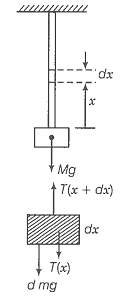Q.25 (1) A steel wire of mass per unit length with a circular cross-section has a radius of 0.1 cm. The wire is of length 10 m when measured lying horizontal, and hangs from a hook on the wall. A mass of 25 kg is hung from the free end of the wire. Assuming, the wire to be uniform and lateral strains << longitudinal strains, find the extension in the length of the wire. The density of steel is 7860 kg m-3. (Young's modulus, Y = 2 x 1011 Nm-2.
(2) If the yield strength of steel is 2.5 x 108 Nm-2, what is the maximum weight that can be hung at the lower end of the wire?


© 2025 GoodEd Technologies Pvt. Ltd.